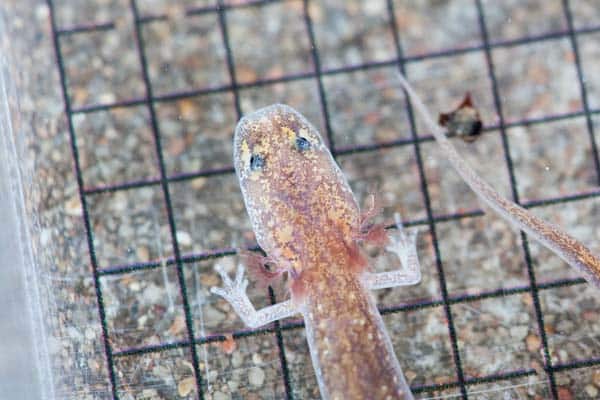At most public swimming pools, you can be pretty sure you won’t encounter an endangered species while taking a dip. But not at Barton Springs Po
At most public swimming pools, you can be pretty sure you won’t encounter an endangered species while taking a dip. But not at Barton Springs Pool in Austin, Texas. Here, if you walk along the concrete edge and down the ramp into the clear, unchlorinated, chilly waters, and swim out to the pool’s far side, you may come face-to-face with a small salamander that was once called “one of the most endangered vertebrate species in North America.”
The source of the water that fills Barton Springs Pool is an expansive underground aquifer. The pool’s bottom is mostly stone, sand, and silt, and the aquifer’s clear, cool springwater jets in through cracks in the limestone. All of this sits in a park within view of downtown Austin, in a landscape now heavily modified by humans. What was once a relatively shallow spring-fed creek flowing toward downtown is now a long, rectangular swimming pool, with a dam at the deep end that raises the water to a depth of about 18 feet. A concrete wall and walkway runs along the pool’s entire north edge, and another wall at the shallow end diverts Barton Creek into a tunnel. More than half a million visitors come here every year to enjoy its consistent, 68- to 70-degree Fahrenheit water.

John Davidson
Devitt holds a Barton Springs salamander caught at Sunken Garden. Although the animals have evolved to spend their entire lives underwater, they can survive out of the water for brief periods.
Despite all the modifications and heavy recreational use, the springs and the pool are still wildlife habitat. Endangered Barton Springs salamanders (Eurycea sosorum), which lived here for untold years before humans began messing with the place, still call the springs home. Small, darting fish, bright red crayfish, aquatic plants, and tiny crustaceans are also part of this coopted ecosystem.
The balance at Barton Springs between an endangered species’ habitat and a treasured public pool has not always been easy. But the salamanders have persisted for two decades since they were declared endangered, even as the human population around them has skyrocketed. These days, Austin’s hard-won equilibrium seems once again at risk.
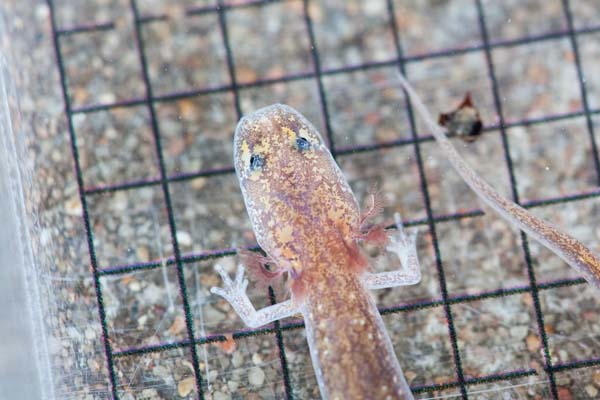
john davidson
One of the Barton Springs salamanders rescued during the cleaning operation. Unlike most salamanders, these salamanders spend their entire lives underwater, and never lose the external gills that they sport as aquatic larvae.
As the growing regional population shifts westward to areas outside city limits, development is intensifying within the section of the aquifer that feeds the springs—beyond the protection of Austin’s ordinances. A major highway extension that has recently broken ground would run through approximately three miles of the Barton Springs recharge zone, land that catches and percolates rainwater down into the aquifer. Many of those who fought for the salamander in the past are refocusing on these new battle fronts, using tools like the Endangered Species Act—a major pillar of the salamander’s tenuous existence.
Yet even the salamander’s federal endangered status is no guarantee of future protection. President Trump’s nomination for Interior Secretary, Montana congressman Ryan Zinke, has opposed endangered species listings in the past. “From his record, it's hard to expect much good will come to any of our wildlife, much less those species at risk of extinction,” says Bill Bunch, an environmental lawyer in Texas who has been part of the so-called “Salamander Wars” ever since they began. Without the Endangered Species Act—or with a defanged version of it—the future of the salamanders, and countless other species, will almost certainly be grimmer. In conservation, the war is never really over. “You never win it forever—you just win it for today,” says Bunch.
Barton Springs salamanders are tiny, only about the length of your pinky finger when full-grown, with speckled, pale, purplish skin and feathery external gills that frame their U-shaped heads. They are found almost exclusively in Barton Springs Pool and three other small pools in the surrounding Zilker Park, an expansive green area just up the road from downtown Austin that’s home to sports fields, bike paths, parking lots, and the massive annual Austin City Limits music festival.
In recent years, scientists have found the salamanders at a handful of other springs, all within the same section of the Edwards Aquifer. This underground limestone labyrinth arcs from Austin down past San Antonio and nearly to the state’s southwestern border, and provides drinking water for about two million people in central Texas; this particular subsection alone feeds the taps of about 60,000 people, in addition to the springs.
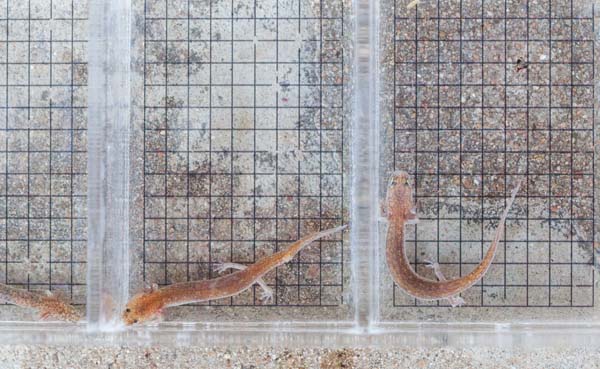
John Davidson
Three Barton Springs salamanders rescued during the drawdown and cleaning of the pool. Once city biologists photograph them and take genetic samples from their tails, they’ll be released back into the springs.
Texas residents, the swimmers at Barton Springs Pool, and the salamanders all depend on clean water. Over the past 25 years, individuals and environmental groups have been fighting hard to protect the salamanders and the city’s water.
As populations have increased, nitrogen levels in the aquifer have slowly risen, in turn reducing dissolved oxygen—critical for salamanders and other aquatic life to survive. Sediment and silt, loosened by development, also fills in the cracks and crevices where salamanders hide out. And the geology isn’t much help: The Edwards is a karst aquifer, consisting of tortuous channels carved into the limestone that carry water quickly with little opportunity for filtration of contaminants. This geologic peculiarity means that a large chemical spill could travel through the aquifer and into the springs in a matter of a day or two—potentially wiping out the entire population of wild Barton Springs salamanders.
Still, although the threats have intensified, legal protections have helped keep the degradation at bay, and have reduced the chances of a catastrophic spill. And despite dire predictions by developers and politicians that protecting the salamanders and the springs would hinder the city’s economic growth, people and amphibians have somehow carved out a genuine and sustainable coexistence.
Starting in 1974 and continuing through the ’80s, Austin was an early adopter of water-protection ordinances. But it was 1990 when the city had its true environmental awakening at an all-night city council meeting attended by more than 800 people. The meeting has come to be referred to as the Barton Springs Uprising. At issue: a proposed massive development of 4,000 acres of homes, businesses, and golf courses within the contributing zone of Barton Springs, a catchment area where rainfall and streams eventually flow into the recharge zone and down into the aquifer. Local celebrities sang songs, and crowds protested on the street outside. Some 150 people had their say at the microphone. When the bleary-eyed councilmembers finally voted just after 6 a.m., they unanimously rejected the development proposal that many had expected would pass.
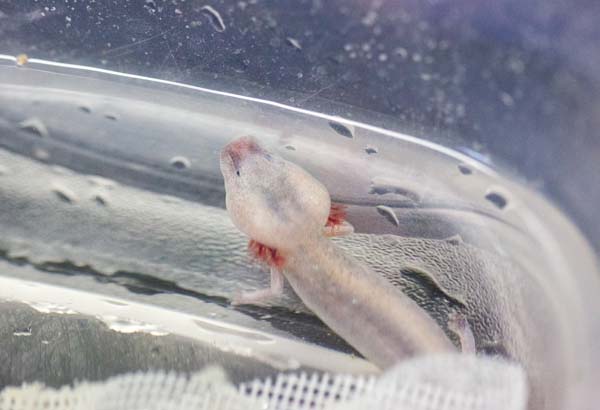
john davidson
Like their cousins the Barton Springs salamanders, Austin blind salamanders are also neotenic, meaning that they maintain certain juvenile characteristics—including their external gills—for their entire lives.
Some of those at the meeting were already scheming about ways to protect the springs more permanently. Bunch, the executive director of the Save Our Springs Alliance, was one of them. I meet him for coffee on a gray morning in November, the day after the presidential election. He’s clean-shaven, with gray hair and glasses, and he speaks softly with a light Texas accent. By 1990, Bunch says, he had already learned the value of using the Endangered Species Act in a place where state environmental protections were weak.
“Getting species that were local, that were threatened by the rapid growth of the area” onto the endangered species list, he says, was an obvious tactic. For this particular fight, he had the perfect candidate: the Barton Springs salamander, known at the time to live only in the Barton Springs Pool and two adjacent springs.
Bunch enlisted Mark Kirkpatrick, a biology professor at the University of Texas-Austin, and Kirkpatrick’s then-wife Barbara Mahler, a doctoral student of hydrogeology, to draft a petition to the U.S. Fish and Wildlife Service, asking them to consider listing the small salamander as endangered. The petition, filed in January 1992, pointed to several factors that threatened the salamander’s continued existence: It lived only in an extremely small area, within a large and growing city, and the water it depended on was highly susceptible to degradation because of the local geology.
If the defeat of the 4,000-acre development was a rumbling of war, this petition was the first airstrike. The Salamander Wars would ultimately span two decades, and would leave Austin a thriving metropolis, the salamanders protected, and a community pool still open to the public.
My first encounter with a Barton Springs salamander comes at Sunken Garden, one of the smaller springs in Zilker Park. The spring sits at the bottom of two sets of crumbling steps, just beyond a locked gate that carries a sign warning of jail time or steep fines for trespassing on “Federally Protected Habitat.” There’s a densely packed neighborhood just across a nearby road, and Barton Springs Pool is only a long stone’s throw away, but the spot feels like a secluded ruin. A circular wall of gray stone, built in the 1930s, surrounds the 40-foot-wide pool. Small trees overhang the edges. Overgrown grasses have been hacked away near the gate. The water itself is pale, transparent aquamarine. And at the bottom, only a few feet down, springwater continuously tosses up small puffs of silt.
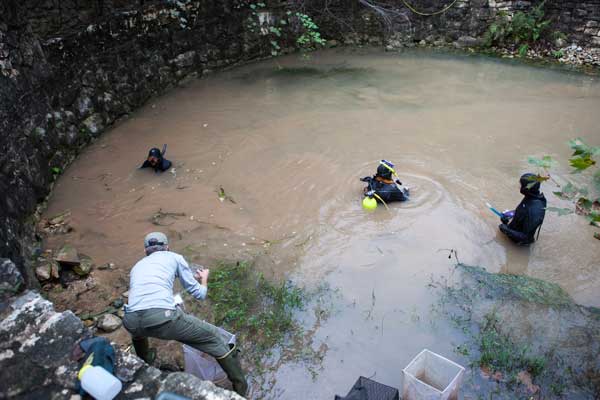
john davidson
Devitt (foreground), Brad Nissen (L), Dee Ann Chamberlain (C), and Donelle Robinson (R) finish up their survey at the Sunken Garden pool, not far from the much larger Barton Springs Pool. There is a lot of silt built up at the pool, due to a combination of naturally occurring erosion, plus increased sediment from construction in the catchment area that feeds the springs. The silt can fill in the cracks and crevices where salamanders like to hide out.
These days, Austin employs four full-time salamander biologists, plus one on a temporary contract. All five are here to conduct one of their periodic surveys of the salamander population, check on habitat conditions, and clear out some of the silt that has built up in the pool. Dee Ann Chamberlain, who has been working here since 1996, tucks her brown bobbed hair under the hood of her wetsuit and pushes off into the water in her SCUBA gear. In her hand is a tiny aquarium net that she’ll use to scoop up any amphibians she might encounter. Meanwhile, Chamberlain’s fellow biologists, Tom Devitt, Donelle Robinson, Nate Bendik, and Brad Nissen search along the pool’s edges and check the water’s temperature and pH.
After about an hour, Robinson calls out that she’s found a salamander. Bendik, who sports a large beard and hip waders, shimmies along the edge and takes the net containing Robinson’s find. “Want to hold him?” Bendik asks, handing me the net. I accept eagerly, peering down at the tiny, squirming creature. Out of the water, its feathery gills are flattened against its head. Its nose is blunt, and its tiny eyes almost make it look blind. The salamander’s back is grayish-purple, covered with gold splotches, and I can barely make out its translucent limbs. Most species of salamander lose their external gills when they metamorphose and head for land. But these and a few other species retain their external gills as adults, and spend their entire lives underwater.
After about two hours of searching, the team has found only two salamanders. One concern they discuss is the amount of silt in the pool, which fills in the spaces where salamanders might otherwise hang out. Silt occurs naturally in the aquifer, but before the wall was built around the spring, the water would have flowed faster and cleared it. Construction and development in the surrounding area also tends to add more silt to the aquifer.
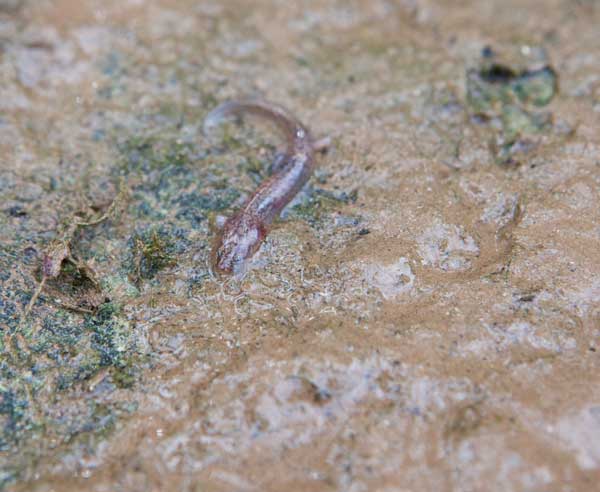
john davidson
A stranded salamander at Barton Springs Pool, almost invisible in the mud. (One of the biologists rescued it soon after this photo was taken.)
Bendik photographs both of the day’s finds; software can identify individual salamanders that they’ve caught before. Devitt also takes a small tissue sample from the end of the salamanders’ tails (which he knows will grow back) for genetic analysis. Then he releases the animals back into the pool. When asked how many Barton Springs salamanders there might be, Devitt is reluctant to even guess. Maybe a few thousand, he says, cautioning that that figure could be way off, due to the inherent challenges of estimating the population of a species that spends so much of its life out of sight.
In August 1992, seven months after the petition to list the salamander, Austin voters passed the Save Our Springs Ordinance. The law set strict limits on development within the Barton Springs recharge and contributing zones Impervious surfaces, like asphalt and concrete that keep water from percolating into the aquifer, had to be as little as 15 percent of each developed parcel. And pollution levels after development could be no higher than they were beforehand. This ordinance was the culmination of more than a year of fights, lawsuits, and a few conspiracy accusations between developers and environmentally minded Austinites like Bunch.
That year also marked a rapid shift in salamander awareness in Austin. After a fish kill in the pool that September, likely caused by chlorine used to control algae, UT-Austin biologist David Hillis raised concerns about the chemical’s impact on salamanders. While some called for the closing the pool to the public entirely, and others fretted about the safety hazards of slippery algae, both sides eventually compromised. Now, every three months, volunteers use brushes, brooms, and power washers, rather than chemicals, to remove algae from Barton Springs Pool, with smaller manual cleanings interspersed throughout the year.
In 1993, Hillis co-authored a paper giving the Barton Springs salamander its official scientific name. The name the scientists chose, sosorum, was inspired by the Save Our Springs Ordinance, or SOS. In the paper, Hillis and his co-authors stated: “Eurycea sosorum appears to have one of the smallest ranges of any vertebrate in North America, occurs in an area of extreme environmental sensitivity, and is highly vulnerable to extinction.”
Despite resistance from developers in the area, the Fish and Wildlife Service gave local conservationists some good news early in 1994: The agency proposed listing the Barton Springs salamander, which would give the species and its ecosystem extensive protections from development or pollution. But a proposal for listing is a long way from an actual listing.
Controversy raged in Austin. “Salamander stirs calls of morality, communism” read one headline in the Austin American-Statesman. Some residents wrote to the paper, expressing support for the salamander, while others expressed horror at the potential dismantling of their property rights.
Just before the one-year deadline of the proposal to list the species—the timeframe required by the Endangered Species Act (ESA)—then-governor George W. Bush asked Secretary of the Interior Bruce Babbitt for a six-month extension. Bush demanded “a thorough investigation of any proposed action by the federal government that has even the potential to impact the use of private property.” Those six months would be used to come up with methods of protecting the salamander and the surrounding watershed, Bush wrote; there would be no need for federal protection. The Fish and Wildlife Service granted the extension.
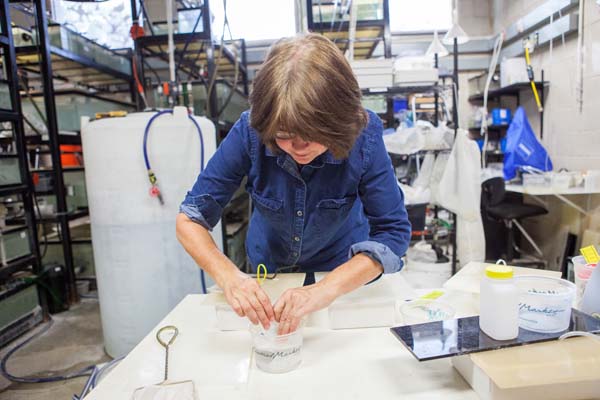
john davidson
Dee Ann Chamberlain, the senior salamander biologist on the city payroll, examines a salamander at the captive breeding facility. She runs the facility, as well as helping to conduct the periodic surveys for salamanders.
Two days after their survey at Sunken Garden springs, the city salamander crew is on hand to monitor the quarterly deep cleaning of Barton Springs Pool. The water level has been lowered several feet by opening gates at its far end. While volunteers and lifeguards scrub the exposed shallow end of the pool, the scientists search for salamanders at the other end that might have been stranded by the lowered water. With small hoses, they gently spray the exposed rock ledges to wash off mud and silt and reveal any hidden creatures. Searching for and rescuing stranded salamanders during these drawdowns is a requirement of the habitat conservation plan.
Nissen, the temp, calls out that he’s found something on an exposed rock ledge and brings over his find: a tiny salamander, exquisitely translucent, like a short bit of a cooked glass noodle. It’s not a Barton Springs salamander, but an even rarer species, the Austin blind salamander (Eurycea waterlooensis). Chamberlain discovered the first one in 1998 at Sunken Garden. At first, she says, she just thought it was another Barton Springs salamander. But after she brought it to the city’s captive breeding facility to help it recover from a damaged tail, she thought it looked a bit strange. Its nose was flatter and its eyes were almost nonexistent. Hillis and others eventually confirmed that this was a new species of blind salamander, living mostly deep in the aquifer but occasionally showing up near the surface. (The Fish and Wildlife Service listed the species as endangered in 2013.)
“You got lucky,” Devitt tells me. “I haven’t seen one in a long time.” Unfortunately, the little creature—no more than an inch long—isn’t doing well. It may have been out of the water too long before Nissen found it. Holding it in a mesh aquarium net, Devitt submerges the salamander in water flowing directly out of one of the fractures in the limestone. He pulls up the net and is rewarded with a weak wriggle from the amphibian. Later, he’ll bring it to Chamberlain’s lab in the hope that it might recover there.
In total during this operation, the team finds four other stranded salamanders in addition to the blind one, all of them Eurycea sosorum. Two of them are fully-grown, much larger than the two found earlier that week at Sunken Garden. And, as Bendik points out, they’re each “beautifully gravid”—that is, carrying eggs. I can see at least a dozen pale yellow dots through the gauzy, speckled skin on each of their bellies. It’s a positive sign that conditions in the pool are at least good enough to allow these individuals to breed.
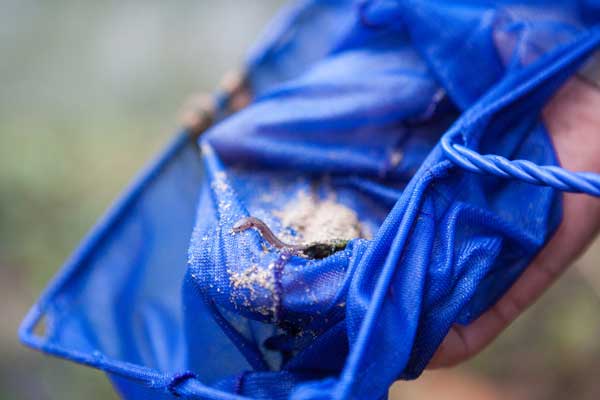
John Davidson
A young adult Barton Springs salamander caught at Sunken Garden. In the wild, the salamanders only grow to a length of 2 or 3 inches.
In the fall of 1995, with the decision on the salamander still pending, the Texas Parks and Wildlife Department published a report by an independent panel of scientists commissioned to review the issues surrounding the species. When the panel presented its findings at a public meeting, Hillis made sure he was first in line to ask a question. The experts had not been tasked with determining whether the salamander was in fact endangered. But Hillis asked Victor Hutchison, a biologist at the University of Oklahoma, for his professional opinion on its status.
According to an article published in the Statesman, Hutchison replied: “The Barton Springs salamander is one of the most endangered vertebrate species in North America, if not the most endangered.”
Less than a month later, Bunch filed a new lawsuit in district court, demanding a decision from Babbitt. But the agency continued to stall. As the two-year mark since the listing petition approached, Bunch and his fellow listing proponents accused the Clinton administration of delaying a decision until after the national elections that November. Finally, on August 28, 1996, Secretary Babbitt announced that the Fish and Wildlife Service was withdrawing its proposal to list the salamander. He said the agency would work with Texas officials to preserve the salamander and its habitat independent of the Endangered Species Act.
“I have no doubt that this will be challenged in court,” Babbitt told the Statesman after the announcement. “That is part of life in the 20th century under the Endangered Species Act.”
Indeed. Two months later, Bunch and Kirkpatrick had sued again, contending that Babbitt had caved to political pressure, rather than basing the listing decision on science. Judge Bunton agreed with the conservationists. “The Court finds that strong political pressure was applied to the Secretary to withdraw the proposed listing of the salamander,” Bunton wrote in March 1997. He gave Babbit 30 days to re-assess its status.
And so, on April 22, 1997—Earth Day—Babbitt announced that the Barton Springs salamander was officially an endangered species.
Governor Bush castigated Babbitt’s decision. In an official press release, Bush said, “Texans will have a hard time trusting a federal government that makes an agreement then turns right around and breaks it.”
Bunch’s reaction was measured. “We shouldn’t have to work this hard for science and law to prevail,” he told the Statesman.
The building that houses Austin’s city-run captive breeding program and hundreds of live salamanders is easy to spot with its giant mosaic salamander climbing up one of its outside walls. The facility was created as a safeguard in case of a catastrophic chemical spill in the catchment area where water flows through the aquifer to the springs. Inside, it looks like an internet server room, with rack after rack of glass tanks instead of computers, each one hooked up with plastic tubing rather than electrical cables.
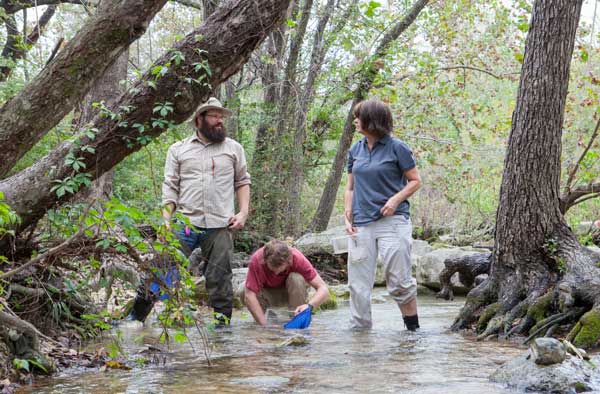
john davidson
Bendik (L), Nissen, and Chamberlain (R) check for salamanders at the one spring site in Zilker Park where humans haven’t extensively modified the surrounding landscape. A couple hundred years ago, this is likely how Barton Springs Pool would have looked.
There’s a constant hum from the pumps and bubblers in each tank that keep the water flowing and oxygenated. Chamberlain, who keeps a framed picture on her desk of the first Barton Springs salamander to lay eggs in captivity, begins to show me around the facility with obvious pride. Most of the time it’s just her and the hundreds of salamanders in here.
She pulls a plastic cover off of one container to reveal a 10-year-old Barton Springs salamander. It’s the biggest one I’ve seen so far, maybe three inches from nose to tail tip, and the salamander’s cranberry-colored external gills curl out from the base of her small head. (No one is sure how long they can live—Chamberlain has one at the facility that’s at least 16 years old and still going strong).
Next she shows me a full-grown Austin blind salamander. The differences in appearance between the two species are obvious now. The blind salamander’s vestigial eyes are just two little dots, and the back of its head is dramatically curved, almost bulbous, and flattens down to a shovel-like, squared-off nose. Its body is much paler, too, a light lavender with rows of white dots running down each side.
At last she uncovers the small blind salamander that the team found during the pool cleaning. The tiny creature rests on a piece of white mesh in a small tub of water, with a bubbler nearby. “I don’t think he’s gonna do well,” Chamberlain says, although she notes that his heart is still beating. At the base of his throat is a tiny red dot. Peering closer, I can see it get slightly larger and smaller as blood pumps through. But the animal itself isn’t moving.
I find out the next day, that the little salamander didn’t survive after all. Its death illustrates the tradeoff between keeping Barton Springs Pool open and cleaned as a community resource, and protecting endangered species.
Hillis recently gave a talk about the salamander. After the official listing, on Earth Day 1997, he said, “Everyone knows what happened next, right? All economic activity stopped, everybody moved away from Austin, and Austin became a complete ghost town.” The audience laughed predictably. Austin is thriving, of course. It’s one of the fastest-growing cities in Texas, and the two counties that contain the Barton Springs recharge and contributing zones are among the fastest-growing counties in the country.
All that growth, while illustrating that protecting endangered species doesn’t necessarily limit economic development, has, in fact, increased the number of threats to the salamanders and the springs. And the relentless development means that Bill Bunch’s work is never done. His current focus is on the new section of highway that would go through the springs’ recharge zone. Bunch and the Save Our Springs Alliance have filed an intent to sue the Texas Department of Transportation and the Central Texas Regional Mobility Authority for failing to adhere to certain requirements of the Endangered Species Act. Not only would construction of the new highway cause an increase in sediment running into the aquifer, says Bunch, but the increased traffic would also increase other contaminants, and the risks of a catastrophic chemical spill.
Just as worrying for the salamander, the Save Our Springs Ordinance only covers Austin itself. Much of the area’s growth is happening to the west, outside city limits. Austin only controls about a quarter of the Barton Springs watershed, and that may not be sufficient to protect the species from future development.
The fate of the ESA itself is another unknown. “There may well be a push from the Republican majority to try to weaken the Act,” says Bunch. In addition, a recent lawsuit filed over an endangered species of spider found only in Texas asserts that the Fish and Wildlife Service should not have authority over the management of endangered species that only occur in a single state—as is the case of the vast majority of endangered species in this country, including the salamanders.
Despite these clear threats, the Barton Springs salamander populations seem stable, for now. When Hillis first arrived, more than 25 years ago, he didn’t think the species would make it. It might not have without the work by Bunch and others. Devitt, the city biologist, believes that the salamander isn’t at risk of extinction in the short term. The existing protections and ordinances should keep the species around, for now. But, he says, “Just because the salamanders seem to be doing okay right now doesn’t mean they will be in the future.”
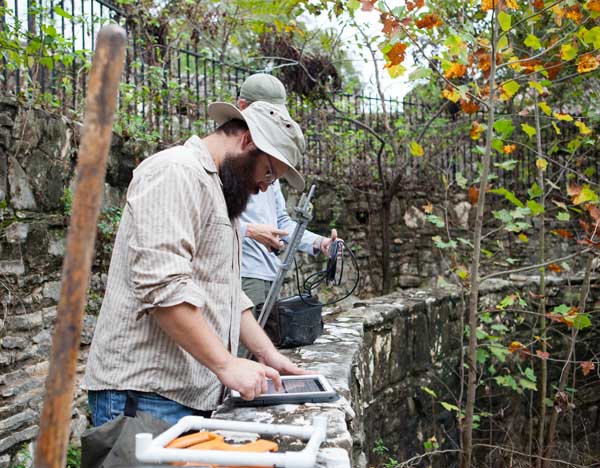
john davidson
Nate Bendik, foreground, and Tom Devitt prepare their equipment before a survey for Barton Springs salamanders at Sunken Garden in Austin’s Zilker Park. Both are salamander biologists employed by the city.
On my last day in Austin, I finally go for a swim in Barton Springs Pool. The sun is bright, and there are about a dozen swimmers out on this warm November Saturday. More people lounge and play on the banks and surrounding grassy slopes. I don my goggles and snorkel and step gingerly into the water. It’s chilly, but not breathtaking. I search for salamanders at the now-submerged spot where the biologists found them earlier in the week, hoping to see one in its natural habitat. The water is incredibly clear. I can feel, but not see, the powerful jets of springwater shooting into the pool from below.
I would love to report that I spotted a salamander lurking just at the edge of a fissure, the clean, fresh water rushing over its gills as it hunkered against the rock. And then, perhaps, it would swim, moving its tiny body sinuously, limbs folded back against its translucent body, suspended in a ray of sunlight, looking like a wingless dragon of Chinese lore.
Unfortunately, I don’t spot a single one. Plenty of large crayfish, ready to brawl with claws held high, and many small fish. But no E. sosorum or E. waterlooensis. Eventually, as my fingers turn white and goosebumps cover my skin, I retreat from the water.
Despite my failure, I know the salamanders are there. And this is, after all, their home; I am merely a visitor. Even a full-blooded Austinite like Devitt is an interloper here. These species adapted to this spring long before humans arrived, and they’ve had no choice but to share it with us. With the web of protections that now shelters them, this coexistence could continue indefinitely. But if those protections are stripped away, weakened, or circumvented, both the salamanders and the humans may ultimately lose out.
This story originally appeared in the online magazine bioGraphic.

